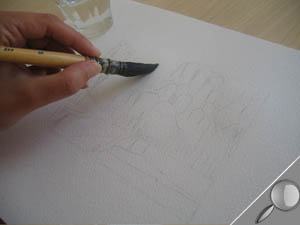
Level of difficulty: intermediate Estimated time: 3 hours
Artist: Cécile Raymond.
A weeping willow is very graphic and especially nice to work with. To represent it, you need to observe it from every angle. Doing so will add that characteristic dash of charm and romanticism to your landscapes!
Material
- Watercolor paper: L'Aquarelle Canson Héritage 300gsm – rough grain
- Colors watercolor: Emerald green Perm lime green Terre-verte Ultramarine F Cerulean blue Indian red Yellow cadmium M Gold ocher Burnt Umber Sepia + blue and black watercolor pencils
- Pencils and paintbrushes: 2B pencil, wash brush, medium round pointed brush.
- Accessories: kneaded eraser









